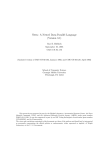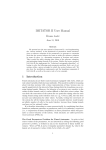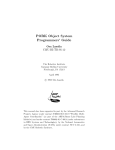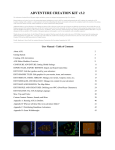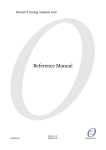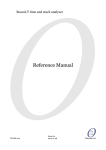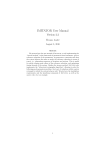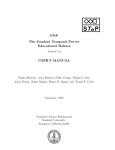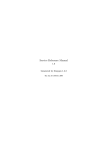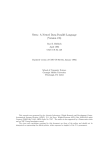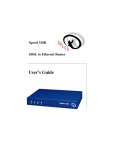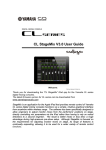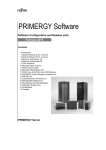Download The Omega Library - Computer Science
Transcript
The Omega Library Version 1.1.0 Interface Guide Wayne Kelly, Vadim Maslov, William Pugh, Evan Rosser, Tatiana Shpeisman and David Wonnacott [email protected] http://www.cs.umd.edu/projects/omega November 18, 1996 Contents 1 Introduction 1.1 About this release . . . . . . . . . . . . . . . 1.1.1 Changes since the last release . . . . . 1.2 What is the Omega Library? . . . . . . . . . 1.3 What are tuple relations and sets? . . . . . . 1.4 What are Presburger formulas? . . . . . . . . 1.5 What are uninterpreted function symbols ? . 1.6 What is the UNKNOWN constraint? . . . . . 1.7 Manipulating integer tuple relations and sets . . . . . . . . . . . . . . . . . . . . . . . . . . . . . . . . . . . . . . . . . . . . . . . . . . . . . . . . . . . . . . . . . . . . . . . . . . . . . . . . . . . . . . . . 2 Compiling And Running Programs With The Omega Library 2.1 2.2 2.3 2.4 2.5 2.6 Introduction . . . . . . . . Avoiding Name Collisions Compiling Templates . . . G++ 2.7.2 . . . . . . . . . Debugging information . . Enabling one-pass linking . . . . . . . . . . . . . . . . . . . . . . . . . . . . . . . . . . . . . . . . . . . . . . . . . . . . . . . . . . . . . . . . . . . . . . . . . . . . . . . . . . . . . . . . . . . . . . . . . . . . . . . . 3 3 3 4 4 4 5 5 5 6 . . . . . . . . . . . . . . . . . . . . . . . . . . . . . . . . . . . . . . . . . . . . . . . . . . . . . . . . . . . . . . . . . . . . . . . . . . . . . . . . . . . . . . . . . . . . . . . . . . . . . . . . . . . . . . . . . . . . . . . . . . . . . . . . . . . . . . . . . . . . . . . . . . . . . . . . . . . . . . . . . . . . . . . . . . . . . . . . . . . . . . . . . . . . . . . . . . . . . . . . . . . . . . . . . . . . . . . . . . . . . . . . . . . . . . . . . . . . . . . . . . . . . . . . . . . . . . . . . . . . . . . . . . . . . . . . . . . . . . . . . . . . . . . . . . . . . . . . . . . . . . . . . . . . . . . . . . . . . . . . . . . . . . . . . . . . . . . . . . . . . . . . . . . . . . . . . . . . . . . . . . . . . 9 . 10 . 10 . 11 Creating relations . . . . . . Building formulas . . . . . . Referring to variables . . . . Building atomic constraints Finalization . . . . . . . . . . . . . . . . . . . . . . . . . . . . . . . . . . . . . . . . . . . . . . . . . . . . . . . . . . . . . . . . . . . . . . . . . . . . . . . . . . . . . . . . . . . . . . . . . . . . . . . . . . . . . . . . . . . . . . . . . . . . . . . . . . . . . . . . . . . . . . . . . . . . . . . . . . . . . . . . . . . . . . . . . . . . . . . . . . . . . . . . . . . . . . . . . . Relations during and after queries Printing . . . . . . . . . . . . . . . Simplication and satisability . . Querying variables . . . . . . . . . Iterating through a DNF . . . . . . Inexact relations . . . . . . . . . . . . . . . . . . . . . . . . . . . . . . . . . . . . . . . . . . . . . . . . . . . . . . . . . . . . . . . . . . . . . . . . . . . . . . . . . . . . . . . . . . . . . . . . . . . . . . . . . . . . . . . . . . . . . . . . . . . . . . . . . . . . . . . . . . . . . . . . . . . . . . . . . . . . . . . . . . . . . . . . . . . . . . . . . . . . . . . . . . . . . . . . . . . . . . . . . . . . . . . . Collections and Iterators . Sequences . . . . . . . . . Lists and Tuples . . . . . Generators . . . . . . . . 5 Querying Existing Relations 5.1 5.2 5.3 5.4 5.5 5.6 . . . . . . . . . . . . . . 4 Building New Relations 4.1 4.2 4.3 4.4 4.5 . . . . . . . . . . . . . . 3 Primitive Data Structures 3.1 3.2 3.3 3.4 . . . . . . . . 1 6 6 7 7 8 8 9 12 12 13 15 16 20 21 21 21 22 22 24 25 6 Creating New Relations From Old 6.1 6.2 6.3 6.4 6.5 6.6 6.7 6.8 6.9 6.10 6.11 6.12 Important warning . . . . . . . . . . . . . . . . Upper and Lower bounds . . . . . . . . . . . . Binary relational operations . . . . . . . . . . . Unary relational operations . . . . . . . . . . . Advanced operations (Hulls, Farkas lemma, ...) Low level relational operations . . . . . . . . . Relational functions that return boolean values Generating code from relations . . . . . . . . . Reachability . . . . . . . . . . . . . . . . . . . . Avoiding copy overhead . . . . . . . . . . . . . Compressing relations . . . . . . . . . . . . . . Reclaiming memory used by Relations . . . . 7 The Uniform Library . . . . . . . . . . . . . . . . . . . . . . . . . . . . . . . . . . . . . . . . . . . . . . . . . . . . . . . . . . . . . . . . . . . . . . . . . . . . . . . . . . . . . . . . . . . . . . . . . . . . . . . . . . . . . . . . . . . . . . . . . . . . . . . . . . . . . . . . . . . . . . . . . . . . . . . . . . . . . . . . . . . . . . . . . . . . . . . . . . . . . . . . . . . . . . . . . . . . . . . . . . . . . . . . . . . . . . . . . . . . . . . . . . . . . . . . . . . . . . . . . . . . . . . . . . . . . . . . . . . . . . . . . . . . . . . . . . . . . . . . . . . . . . . . . . . . . . . . . . . . . . . . . . . . . . . . 27 27 27 27 29 30 31 32 32 34 34 34 34 35 7.0.1 Introduction . . . . . . . . . . . . . . . . . . . . . . . . . . . . . . . . . . . . . . . . . 35 7.0.2 Usage . . . . . . . . . . . . . . . . . . . . . . . . . . . . . . . . . . . . . . . . . . . . . 35 2 Chapter 1 Introduction 1.1 About this release This user manual corresponds to version 1.1 of the Omega Library. While we have tested the code extensively, it is still research software, and we are constantly working on and improving the code. In other words, you should expect that there are still undiscovered bugs in this software. If you use this library, drop us a line and let us know what you're using it for, and what you would like to see in future releases. 1.1.1 Changes since the last release There are several important changes from the last release. Inexactness changes The most visible change to programmers is that relations which contain the constraint UNKNOWN are now handled more sanely. As a result, functions which query whether a relation is satisable or is a tautology have changed to reect the fact that you cannot always get a denitive answer in the presence of UNKNOWN. In addition, there are new functions for checking subsets, plus two new functions for taking upper and lower bounds of relations. Users may have to make some changes to their code in order to compile with the new release. You can safely make the following substitutions and have your code work as with version 1.0: Relation::is satisfiable to Relation::is upper bound satisfiable Relation::is tautology to Relation::is obvious tautology Is Subset to Must Be Subset Variables types replaced by variable kinds It used to be that variables has types, such as input variable, output variable, global variable, and so on. To prepare the way for variables having types such as integer, enumeration and rational, and avoid the confusion that would be caused by having both types oating around, the previous uses of variable types were changed to variable kinds. Old Name New Name File Var Type Var Kind pres gen.h Global Type Global Kind pres var.h Var Type Var Decl::type() Var Kind Var Decl::kind() pres var.h void set type(Var Type v) void set kind(Var Kind v) pres var.h Global Type Global Var Decl::type() Global Kind Global Var Decl::kind() pres var.h Convex Hull We now provide an exact convex hull computation, as well as variations such as ane hull, linear hull and conic hull Sch86]. 3 The Uniform library This distribution includes the Uniform library, a source to source parallelizing transformation system. Reachability The library now includes a function to compute graph reachablity problems. 1.2 What is the Omega Library? The Omega Library is a set of C++ classes for manipulating integer tuple relations and sets. We use the Omega Library in many of our research projects in the area of compilation for high-performance computers. Current applications include dependence analysis, program transformations, generating code from transformations, and detecting redundant synchronization. It is also the basis for the Omega Calculator, which is described separately. This manual describes how to use the Omega library in your programs. The copyright notice and legal ne print for the Omega calculator and library are contained in the README and omega.h les. Basically, you can do anything you want with them (other than sue us) if you redistribute it you must include a copy of our copyright notice and legal ne print. 1.3 What are tuple relations and sets? An integer k-tuple is simply a point in Z k . An integer tuple relation is a mapping from tuples to tuples. The tuple that is being mapped from is refered to as the input tuple and the tuple that is being mapped to is refered to as the output tuple. All the integer tuple relations we consider map from k-tuples to k -tuples for some xed k and k . We refer to k and k as the input and output arities respectively. A integer tuple set is a set of k-tuples, for some xed k. We'll often abbreviate integer tuple relations and integer tuple sets as relations and sets respectively. The sets and relations that we use may be innite or may depend on the values of other variables, so it is generally not possible to describe them simply by enumerating their tuples or pairs of tuples. Instead, we introduce variables that correspond to each of the positions in the input and output or set tuples and construct a formula that has these and other variables as free variables. These variables are refered to as input, output or set variables as appropriate. For example, we would represent the set of all even numbers as: f i] j 9 s:t: i = 2 g In this case we introduce a single set variable because we are describing a set of 1-tuples. The formula in this case is 9 s:t: i = 2 , note that i is the only free variable in this formula. If we wanted to represent the set of all positive even numbers less than n we would use: f i] j 9 s:t: i = 2 ^ 0 < i < n g We refer to variables such as n as symbolic or global variables. They are global in the sense that can be used in more than one relation and they represent the same value in all relations. This becomes important when we apply relational operations that combine variables and constraints from dierent relations. As another example, to represent the relation corresponding to integer addition we would use: f i1 i2] ! j1 ] j i1 + i2 = j1 g The Omega library can represent relations and sets that can be described by Presburger formulas (possibly with limited uses of uninterpreted function symbols). 0 0 0 1.4 What are Presburger formulas? Presburger formulas KK67] are those formulas that can be constructed by combining ane constraints on integer variables with the logical operations :, ^ and _, and the quantiers 8 and 9. The ane constraints can be either equality constraints or inequality constraints (abbreviated as EQs and GEQs respectively). For example, the formulas in the previous section are Presburger formulas. There are a number of algorithms for testing the satisability of arbitrary Presburger formulas KK67, Coo72, PW93].n The best known upper bound on the performance of an algorithm for verifying Presburger formulas is 222 Opp78], and we have no reason to believe that our method will provide better worst-case performance. However, our method may be more ecient for many simple cases that arise in our applications. 4 1.5 What are uninterpreted function symbols ? Presburger arithmetic can be extended to allow uninterpreted function symbols. Formulas in this extended class may contain terms representing the application of a function to a list of argument terms. For example, the following extended presburger formula contains an uninterpreted function symbol F: 1 i i n ^ F(i) 6= F(i ) ^ 1 j j m The functions are termed \uninterpreted" because the only thing we know about them is that they are functions: two applications of a function to the same arguments will produce the same value. Applications of function symbols can be used to represent values that vary with the values of certain other variables. For example, when we perform dependence analysis with the Omega Library, we would use a scalar global variables to represent the value of a symbolic constant in the program, and a function of arity 2 to represent the values taken on by a non-linear expression nested in two loops (see PW94] for a more detailed discussion of, and examples of, the use of function symbols to represent non-linear terms). Downey (Dow72]) proved that full Presburger arithmetic with uninterpreted function symbols is undecidable. We therefore restrict our attention to a subclass of the general problem, and produce approximations whenever a formula is outside of the subclass. Whenever an approximation is produced, it is marked as either an upper bound or lower bound as appropriate. We currently restrict our attention to formulas in which all function symbols are free, and functions are only applied to a prex of the input or output tuple. For example, a binary function could be applied to the rst two input or the rst two output variables of a Relation (or the rst two variables of a set's tuple). 0 0 0 1.6 What is the UNKNOWN constraint? A conjunction may contain the constraint UNKNOWN. UNKNOWN indicates the existence of one or more other constraints in the Presburger formula that aren't known. Such constraints could arise from the need to approximate (as from some cases of uninterpreted function symbols or transitive closure), or because the user added it to the formula. A relation which includes the UNKNOWN constraint is said to be inexact. Inexactness can be removed by taking an upper or lower bound on the inexact relation. Inexactness is discussed further in sections 4.4, 5.3 and 5.6, and creating upper and lower bounds is discussed in section 6.2. 1.7 Manipulating integer tuple relations and sets A common way to use the library is to build relations and/or sets describing your particular problem, perhaps combine them using the relational operators, and then query them in some way (checking information about a particular variable, checking to see if its formula is satisable, or just printing them to the screen.) In Chapter 4, we describe how to build new relations and sets. In Chapter 5,we describe how to examine existing relations. This includes generating a user readable string representation of a set or relation, and examining the conjuncts and constraints of a relation once it has been simplied and converted into disjunctive normal form (DNF). In Chapter 6, we describe how to create new relations from old relations by applying relational operations such as intersection, union, domain, range, and composition. In Chapter 2, we discuss some issues related to the compilation of the Omega Library and programs that use it. In Chapter 3, we describe some of the primitive data structures used in the library (such as strings and tuples). 5 Chapter 2 Compiling And Running Programs With The Omega Library 2.1 Introduction To use the Omega Library in an existing C++ application, it is necessary to: Use the makele included in the release to make libomega.a if it doesn't already exists. Include -lomega as an option to the linker. Include -Ldir as an option to the linker, where dir is a directory that contains libomega.a. Add the line #include "omega.h" to each application source le that references Omega library data structures or functions. If the include le omega.h and the associated omega subdirectory have not been placed in a standard include directory on your system, use -Idir/include as an option to the compiler, where dir is a directory that contains the include directory from this release. Make any modications that are needed to get the Omega Library and your code to compile with compatible compilers (see Section 2.3). 2.2 Avoiding Name Collisions Some of the global names in our library are simple enough that they may conict with names used in your code or some other library you use. We have taken the following steps to ensure that such conicts can be resolved easily - these are based on vague memories of something from the documentation of the InterViews project, so to the degree that the approaches are similar, that project should get the credit. In a header le that denes an obvious name, such as String, we replace (via #define) that name with some less obvious name, such as Omega String. This ensures that these obvious names do not appear in the library, even though we use them in our code. In case of conict, just #undef the obvious name after the inclusion of omega.h, but before the inclusion of the header le that causes the conict. For example, if you need to use both the Omega Library and Motif (which denes the name String), rst #include omega.h, then #undef String (or, alternatively, #include omega/basic/leave String.h, which does this), and then #include the necessary Motif header les. If you nd a conict in a header that we have not prepared as described above, let us know so that we can x this in the next release. In the meantime, it should be fairly easy to install this x yourself and re-compile. 6 2.3 Compiling Templates This software should compile correctly with either g++ 2.5.8 or g++ 2.6.3, as long as the proper ags are used (-fno-implicit-templates and -DDONT INCLUDE TEMPLATE CODE for g++ 2.6.3). We take advantage of some of the new features of g++ 2.6.3 to ensure that the code for templates is not duplicated (this reduces the size of the executable by about 32 ). This makes the compilation a bit more complicated: this section describes some of the techniques we use to make it work reasonably well. A parameterized class's declaration is in a \.h" le and the code for its member functions in a \.c" le. The \.c" les for parameterized classes are kept in the include directory, as they are #include-d rather than compiled separately. Each class' \.h" le also contains a macro that expands to list all the other templates associated with a template you might be using. These macros, including those for types used by the Omega Library, should all be used expanded in one le, to avoid redundant denitions. The le \include/omega/PT-omega.c" contains a list of all the templates used by the Omega Library, and can be used to simplify the construction of a single le that contains all parameterized types. For example, the le \PT.c" is used in the compilation of the Omega Calculator: It #includes omega/PT-omega.c and explicitly lists the other parameterized types used by the calculator. The functions of these features depend on the compiler being used: G++ 2.5.8 The declaration and denition of all template functions must be given in every header le. To accomplish this, the header le for a given class #includes the \.c" le with the code for that class's member functions. The \.c" le should not be compiled directly. \PT-omega.c" and \PT.c" are not needed - fortunately g++ 2.5.8 ignores their contents. G++ 2.6.3 The denitions of the external template functions must not be included in multiple source les. We therefore use -fno-implicit-templates and -DDONT INCLUDE TEMPLATE CODE when compiling - the latter prevents inclusion of the \.c" les by the headers. The le \PT.c" #undefs DONT INCLUDE TEMPLATE CODE before including the headers, so it will get the function denitions. It #includes \PT-omega.c", so this one source le will contain a copy of each template needed anywhere in the Omega Calculator. Note that our instantiate macros contain some redundancies, and the compiler will issue warnings about them, so warnings for PT.c are turned o in the makele. 2.4 G++ 2.7.2 The library can also be compiled with G++ 2.7.2, using the same options as for G++ 2.6.3. Due to some changes in the C++ language standard, the compilation produces lots of warnings, but correct code is produced. The rst change is to the scope of variables declared inside a for loop. Most of our code has been adapted to use syntax that works with both the old and new rules. We use the -fno-for-scope option to allow the old syntax in places where it hasn't been xed. Eventually, we will convert all such loops, but until most compilers use the new scoping, we want to allow the use of older compilers. The second change is to prohibit passing an rvalue as a non-const reference parameter. We often re-use parts of Relations in relational operators, which destroys them to avoid this destruction when passing a relation, we use a copy function. Unfortunately, this results in a warning, since the result of copy is an rvalue. We hope to address this problem in a future release. Other C++ compilers Please let us know if you succeed in getting our code to compile with something other than g++. 7 2.5 Debugging information The library has some internal debugging output that you can turn on. It may not be useful to you, since it makes reports about internal functions of the library. All debugging goes to the le DebugFile, which defaults to stderr. You can assign a FILE* to that variable to redirect debugging output. To turn o all debugging, call the function all debugging off(). To use the ags as they are used in the calculator (without the calculator debugging ag) call the function process pres debugging flags(char *arg,int &j) where arg points to a character string with letter]digit] pairs, each digit] is between 1 and 4, and j is an oset into the string at which to start processing ags. If the digit is omitted, it is assumed to be 1. The letters mean: a: all debugging ags c: omega core internal debugging g: code generation debugging p: Presburger formula debugging (simplication, creation) r: relational operators o: print results upon exiting omega core t: transitive closure debugging As an example, your program might use the -D ag to introduce Omega library debugging ags, and a use of this might be -Dp1r1. Your code should recognize the -D ag and pass a pointer to the beginning of the p1r1 string to process pres debugging flags. 2.6 Enabling one-pass linking The g++ compilers perform linking in one pass. This puts some restrictions on the structure of the library being linked. Namely, it should be possible to topologically sort all the library object les according to the call graph. This restriction doesn't apply to the virtual functions, which are always linked in. Unfortunately, the logical structure of the Omega library does not allow to us distribute functions among the les in a such a way that this restriction holds. To resolve this problem, we force some functions to be always linked into the executable (just as the virtual functions are always linked in.) This is implemented in the lib hack.c le, whose only purpose is to enable this trick. The target check order in the makele allows you to check that a correct ordering of functions in the library exists (accounting for the functions that are always linked). You never need to do this if you only use the functions the library provides only users who extend the library should ever need to check this. 8 Chapter 3 Primitive Data Structures The library uses a few generic data structures extensively. All of these data structures are templatized, so they can be used with any type that denes the comparison operations they require. This section provides an introduction to the most frequently used operations dened on these data structures. 3.1 Collections and Iterators All of the one dimensional collection types we use are derived from the Collection class. The elements contained in a collection can be examined via the creation of an iterator - dierent collections will have dierent kinds of iterators, all of which are derived from class Iterator. Any collection must be able to allocate (via new) the appropriate type of iterator. The iterator can be dereferenced (via operator *) to access the current element or incremented (via operator ++) to move to the next element. If an iterator is used where a boolean is required (e.g. in the conditional expression of a for loop), the operator bool() function will return true i there are more elements to be iterated over. The class declarations include the following lines: template<class T> class Collection { public: Iterator<T> *new_iterator() Any_Iterator<T> any_iterator() int size() const } template<class T> class Iterator { public: T & operator*() void operator++() operator bool() const } We can therefore enumerate the elements of any collection as follows: int sum(Collection<int> &c) { Iterator<int> *i int s = 0 for (i = c.new_iterator() (*i) (*i)++) s += *(*i) 9 delete i return s } As it is easy to forget that the new iterator must later be deleted, we have provided the type , which handles this issue automatically. Any Iterator int sum(Collection<int> &c) { int s = 0 for (Any_Iterator i = c.any_iterator() i i++) s += *i return s } Caveats If a collection is changed (elements are added or removed), all the behavior of any iterators on that collection is, in general, not dened. Both the new iterator and any iterator functions cause heap allocation. If we know what kind of collection we are working with, we can avoid the overhead inherent in this allocation by using a specialized iterator for that type of collection (such as a List Iterator for a List, as in Section 3.3). Note that iterators can also be manipulated via an alternate set of functions: live(), curr(), and next(). These are particularly useful in a debugger, where the other syntax can be dicult to use. Many classes in the Presburger library have iterators to walk through the structure { iterators over conjunctions in a formula in disjunctive normal form, iterators over constraints in a conjunction, or iterators over variables in a constraint. These will be discussed in more detail later. 3.2 Sequences Collections in which the elements are ordered are derived from class Sequence. The elements of a sequence can be accessed via subscripting, though the eciency of this operation varies with the particular kind of sequence. The index function gives the index of an element - for any value v in a list l, ll.index(v)] == v. Note that subscripts start an 1, not 0 the index function returns 0 if the element is not in this list. 3.3 Lists and Tuples The most commonly used collections are List and Tuple you may also encounter Bag, Ordered Bag and Map (which is not derived from Collection), although no public functions return these types. Lists are sequences with O(n) access time for the nth element. They add the following operations to those of class Sequence: template<class T> class List : public Sequence<T> { public: int length() const int empty() const T &front() 10 // insertion/deletion on a list invalidates any iterators // that are on/after the element added/removed T void void void void void void remove_front() prepend(const T &item) append(const T &item) ins_after(List_Iterator<T> i, const T &item) del_front() del_after(List_Iterator<T> i) clear() void join(List<T> &consumed) } Tuples are essentially re-sizable arrays: they provide O(1) time access to elements. They provide bounds checking. template <class T> class Tuple : public Sequence<T> { public: Tuple<T>& operator=(const Tuple<T>&) int length() const int empty() const void void void void void delete_last() append(const Tuple<T> &) append(const T &) join(Tuple<T> &consumed) clear() } These classes have associated iterator classes: List Iterator and Tuple Iterator, which can be initialized with a List or Tuple to be iterated over, allowing iteration without the overhead of heap allocation that is incurred when we use the more general new iterator or any iterator functions: int sum(List<int> &l) { int s = 0 for (List_Iterator<int> i = l i i++) s += *i return s } 3.4 Generators Generators are similar to iterators in that they provide us with sequential access to a collection of values. Iterators provide read and write access to elements that are actually stored in some collection. The sequence of values provided by a generator need not actually be stored in any collection, and thus a generator does not provide an lvalue. 11 Chapter 4 Building New Relations The upcoming chapters will share three running examples the gures that contain the code can be concatenated to produce a valid example program for the Omega Library (the le library example.c, distributed with the postscript le for this manual, contains this code). We will see how to create the following very simple set, slightly more complicated set, and relation: S1 := f t] j 1 t n g S2 := f x] j (0 x 100 ^ 9y s:t: (2n y x ^ y is odd)) _ x = 17 g R := f i j] ! i j ] j 1 i i n ^ :(F(i) = F (i )) ^ 1 j j m g In this chapter, we'll describe how to construct relations and sets from scratch. We'll describe how to declare relations create and use the variables used within Presburger formulas and how to build Presburger formulas that describes membership in the set or relation. 0 0 0 0 0 4.1 Creating relations What we've referred to up until now as \sets" and \relations" are implemented as a single class, Relation. Each relation is marked as being either a set or a relation. Most functions on relations don't care whether they operate on sets or relations, but some require either a set or a relation, and they will check. We provide the following constructors for Relations: Relation() This is a default constructor for the class. Relations created this way are known as null relations and must be assigned a value before they can be used. This constructor is provided to allow the creation of arrays of relations. Relation(int n input, int n output) This constructor creates a relation with n input input variables and n output output variables. It can't be used in any functions yet, because it doesn't have a Presburger formula to describe which tuples it contains. Relation(Non Coercible<int> nci) This constructor creates a set. In normal use, you should pass an int to this function to get a set with that many variables in its tuple. (The class Non Coercible<int> is used as a C++ trick so that you couldn't, for example, pass an int to a function expecting a Relation, and have the compiler construct a Relation from it on the y.) Relation(const Relation &r, Conjunct *c) This is used to create a relation by copying a conjunction of constraints c, from some other relation r. Conjuncts are created when a relation is simplied into disjunctive normal form and will be described in Chapter 5. 12 The input, output, or set variables can be given names: void Relation::name input var(int nth, String s) nth s Set the name of the input variable to . void Relation::name output var(int nth, String s) nth s Set the name of the output variable to . void Relation::name set var(int nth, String s) nth s Set the name of the set variable to . If you don't name the variables yourself, each variable will get a name that depends on its position in the input or output tuple. If two variables in the same relation are given the same name, the print functions will add \primes" to one of them to distinguish them. The following are some simple functions that extract information about a set or relation: bool Relation::is set() Return true if the relation is a set, false if it is a relation. int Relation::n inp() Find out how many variables are in a relation's input tuple. int Relation::n out() Find out how many variables are in a relation's output tuple. int Relation::n set() Find out how many variables are in a set's tuple. The rst six lines of Figure 4.1 show how the Relation constructors and some of the functions above are used to create the relations in our examples. 4.2 Building formulas Presburger formulas are represented as a tree of formula nodes. Formula is the base class from which all classes of formulas nodes are derived. Depending on their class, formula nodes can have zero or more children. Children can be either other formula nodes or \atomic" constraints (single equality, inequality, or stride constraints). Formula is an abstract base class a plain Formula node can never be used in a tree. The various subclasses of formulas are: F And Represents the logical conjunction of its children nodes. An F And node with no children represents \True". In our current implementation, atomic constraints can only be added as children of F And nodes. F Or Represents the logical disjunction of its children nodes. An \False". F Or node with no children represents F Not Represents the logical negation of its single child node. F Declaration This subclass of Formula is the abstract base class for all subclasses of variable declarations. F Forall F Forall Formula that can contain nodes have associated with them one or more variables. These variables are universally quantied in the formula represented by the F Forall node's single child node. 13 #include <omega.h> main() { Relation S1(1), S2(1), R(2,2) S1.name_set_var(1, "t") S2.name_set_var(1, "x") assert(!R.is_set()) assert(S1.is_set()) assert(S2.is_set()) Free_Var_Decl n("n") Free_Var_Decl m("m") Free_Var_Decl f("F", 1) Variable_ID S1s_n = S1.get_local(&n) Variable_ID S2s_n = S2.get_local(&n) Variable_ID Variable_ID Variable_ID Variable_ID Rs_n = R.get_local(&n) Rs_m = R.get_local(&m) Rs_f_in = R.get_local(&f, Input_Tuple) Rs_f_out = R.get_local(&f, Output_Tuple) Variable_ID Variable_ID Variable_ID Variable_ID i = R.input_var(1) j = R.input_var(2) i2 = R.output_var(1) j2 = R.output_var(2) Variable_ID t = S1.set_var(1) Variable_ID x = S2.set_var(1) Figure 4.1: Example, Part 1: Declaring Relations and Variables 14 F Exists F Exists nodes have associated with them one or more variables. These variables are existentially quantied in the formula represented by the F Exists node's single child node. Children can be added to any subclass of formula using the following member functions. They all return pointers to the newly created child node. F And * Formula::add and() F Or * Formula::add or() F Not * Formula::add not() F Forall * Formula::add forall() F Exists * Formula::add exists() The F And * Formula::and with() member function is also useful. Its eect is equivalent to replacing the formula that it is called on with an F And node with the old formula as one of its children and another F And node as its other child. This second F And node is returned as the result. Analogous versions of these member functions exist for the Relation class. A Relation can have only one child formula node. In many cases, it is necessary to create a relation that contains all pairs of tuples (its formula is \True"), or that contains no pairs of tuples (its formula is \False".) It is possible to use the above constructors and member functions to create such relations. But since these relations are so common, we provide a shorthand way of creating them. The static member functions Relation Relation::True and Relation Relation::False return relations or sets with \True" and \False" respectively as their formulas. If one integer argument is provided then a set is returned this arity. If two integer arguments are provided then a relation is returned with these input and output arities respectively. 4.3 Referring to variables An object of class Var Decl represents all uses of a variable in a particular relation. Var Decls should never be created explicitly by application programs they are created implicitly by member functions of various library classes. We will usually use Variable IDs, which are pointers to Var Decls, to refer to such objects. To create constraints on a particular variable, it is necessary to determine the Variable ID of that variable in the relation to which we want to add the constraints. We now explain how to obtain Variable IDs for various types of variables: Input, output, and set variables The Relation member functions input var(int n), output var(int n), and set var(int n) produce Variable IDs for the nth variable in the appropriate tuple. It is illegal request an input or output variable of a set, or to request a set variable from a relation. Quantied Variables The member function Variable ID F Declaration::declare creates a new Var Decl and add it to the list of variables associated with the F Declaration node that it is called on. It returns the Variable ID for the newly created variable in the current relation. If a String is specied as an argument to the member function then that String is recorded as the name of that variable, otherwise the variable remains unnamed. Scalar Global Variables The variables we have seen so far have all been local to a single relation. Global variables, on the other hand, may be shared between relations. A global variable is created by creating an object of a class derived from Global Var Decl. The class Free Var Decl is an example of such a class, and is used for the global variables in the code in our examples (e.g., the creation of the global variables n 15 and m in Figure 4.1)). New subclasses of Global Var Decl can be created to keep track of any additional information that applications may want to record about global variables. The member function Variable ID Relation::get local(const Global Var Decl *) is used to return the Variable ID of a scalar global variable in a particular relation. In Figure 4.1, the Variable ID Rs n is used to identify the global variable n in the relation R. Global Variables Representing Uninterpreted Function Symbol As was the case for scalar global variables, global variables representing uninterpreted function symbol are created by creating objects of a class derived from Global Var Decl. Once again, class Free Var Decl is an example of such a class, but this time we need to use a Free Var Decl constructor that allows us to specify an arity, as shown by the creation of f in Figure 4.1. The enumeration Argument Tuple, which contains the values Input Tuple, Output Tuple, and Set Tuple, is used to specify the tuple to which an uninterpreted function symbol is to be applied. Since an uninterpreted function symbol can be applied to both the input and output tuple of a relation, two Var Decls per relation may be necessary: one for the function applied to the input tuple and the other for the function applied to the output tuple. The member function Relation::get local(const Global Var Decl *, Argument Tuple). is used to return the Variable ID of one of these Var Decls depending on which Argument Tuple is requested. For example, we use this function to get the Variable ID's for Rs f in and Rs f out for the global variable f in Figure 4.1. There are a few things you can nd out about a variable given its Variable ID: String Var Decl::base name The name of the variable without primes. Var Kind Var Decl::kind() Returns the kind of the variable one of fInput Var, Output Var, Set Var, Global Var, Forall Var, , (a Wildcard Var is equivalent to an existentially quantied variable, but appears only in simplied relations). Exists Var Wildcard Varg int Var Decl::get position() If the variable is an input, output, or set variable, returns its position in the tuple. Global Var ID Var Decl::get global var() If a variable corresponds to a global variable, returns its Global Variable ID. Argument Tuple Var Decl::function of() If a variable corresponds to a global variable, returns the argument to which it is being applied. Note that there is no way to nd out which relation a Variable ID is associated with, and our implementation is free to either share Variable IDs between relations or not (i.e., the result of S1.set var(1) == S2.set var(1) is not dened). Figures 4.3 and 4.3 show many uses of formula building functions, as well as the creation of many equality and inequality constraints (see below). The creation of the variable y in the middle of Figure 4.3 shows the use of F Declaration::declare(Const String). 4.4 Building atomic constraints P Atomic come in three forms:Pequalities of the form ai xi + a0 = 0, inequalities of the form P aixi +constraints a0 0, and stride constraints ( aixi + a0 is divisible by step). Atomic constraints are manipulated using the EQ Handle, GEQ Handle, and Stride Handle classes. These are derived from the class Constraint Handle. They are referred to as \handles", because atomic constraints do not exist as independent objects. Instead, they are components of another class that is known only to the implementation each Constraint Handle contains information about how to access a particular constraint. The following functions can be used to add an atomic constraint to an F And: 16 F_And *S1_root = S1.add_and() GEQ_Handle tmin = S1_root->add_GEQ() // t-1 >= 0 tmin.update_coef(t, 10) tmin.update_coef(t, -9) // t now has coef. 1 tmin.update_const(-1) GEQ_Handle tmax = S1_root->add_GEQ() // n-t >= 0 tmax.update_coef(S1s_n,1) tmax.update_coef(t, -1) F_Or *S2_root = S2.add_or() F_And *part1 = S2_root->add_and() GEQ_Handle xmin = part1->add_GEQ() xmin.update_coef(x,1) GEQ_Handle xmax = part1->add_GEQ() xmax.update_coef(x,-1) xmax.update_const(100) F_Exists *exists_y = part1->add_exists() Variable_ID y = exists_y->declare("y") F_And *y_stuff = exists_y->add_and() GEQ_Handle ymin = y_stuff->add_GEQ() ymin.update_coef(y,1) ymin.update_coef(S2s_n,-2) GEQ_Handle ymax = y_stuff->add_GEQ() ymax.update_coef(x,1) ymax.update_coef(y,-1) Stride_Handle y_even = y_stuff->add_stride(2) y_even.update_coef(y,1) y_even.update_const(1) F_And *part2 = S2_root->add_and() EQ_Handle xvalue = part2->add_EQ() xvalue.update_coef(x,1) xvalue.update_const(-17) Figure 4.2: Example, Part 2: Adding Constraints to S1 and S2 17 F_And *R_root = R.add_and() GEQ_Handle imin = R_root->add_GEQ() imin.update_coef(i,1) imin.update_const(-1) GEQ_Handle imax = R_root->add_GEQ() imax.update_coef(i2,1) imax.update_coef(i,-1) GEQ_Handle i2max = R_root->add_GEQ() i2max.update_coef(Rs_n,1) i2max.update_coef(i2,-1) EQ_Handle f_eq = R_root->add_not()->add_and()->add_EQ() f_eq.update_coef(Rs_f_in,-1) f_eq.update_coef(Rs_f_out,1) // F(In) - F(Out) = 0 GEQ_Handle jmin = R_root->add_GEQ() jmin.update_coef(j,1) jmin.update_const(-1) GEQ_Handle jmax = R_root->add_GEQ() jmax.update_coef(Rs_m,1) jmax.update_coef(j,-1) GEQ_Handle j2min = R_root->add_GEQ() j2min.update_coef(j2,1) j2min.update_const(-1) GEQ_Handle j2max = R_root->add_GEQ() j2max.update_coef(Rs_m,1) j2max.update_coef(j2,-1) Figure 4.3: Example, Part 3: Adding Constraints to R 18 EQ Handle F And::add EQ() Creates an equality constraint as a child of the F And node and returns a EQ Handle for this constraint. All variables implicitly have a coecient of zero in this constraint. GEQ Handle F And::add GEQ() Creates an inequality constraint as a child of the F And node and returns a GEQ Handle for this constraint. All variables have an implicit coecient of zero in this constraint. EQ Handle F And::add stride(int step) The eect of this function is equivalent to creating an F Exists node with a new variable alpha as a child of the F And node and creating an equality constraint as a child of the F Exists node. The coecient of alpha in this constraint is step and the coecients of all other variables is implicitly zero. This can be used to add constraints like \y is odd" or \x+2y+17 is divisible by 3". void F And::add unknown() Adds an unknown constraint as a child of the F And node, thus making the formula an upper bound (see Section 5.6). You don't need to use this function unless you are creating an inexact relation. Sometimes you may have a relation (perhaps passed in to a function) that you want to modify by adding some constraints to it, but you don't have any pointers into the formula. In these situations, you can use the functions Relation::and with GEQ and Relation::and with EQ. The aect of calling these functions without arguments, on a relation R, with formula f, is equivalent to creating a constraint e of the appropriate type, changing R's formula to be an F And node with f and e as children and returns a Constraint Handle of the appropriate type for e. All variables have an implicit coecient of zero in e. There's another version of this function that allows you to copy constraints between relations. If you call either function with a Constraint Handle c as an argument, the aect is the same except that the coecients of e are set to be the same as the coecients of c. Notice that the latter form allows you to convert EQ's to GEQ's and vice-versa the coecients are copied, and the resulting constraint just has the semantics of whatever kind of constraint you asked for. It's a little confusing, but it saves you from copying each coecient individually. The coecients of variables and the constant terms in constraints can be updated by using the following member functions: functions: void Constraint Handle::update coef(Variable ID, int delta) delta Variable ID Add to the coecient of the variable corresponding to . void Constraint Handle::update const(int delta) delta Add to the constant term of the constraint. void Constraint Handle::multiply(int multiplier) multiplier Multiply each coecient and the constant term by . Warning: Remember that these functions add delta to the current value of a coecient. There is no way to simply set a coecient. This provides us with certain freedoms in our implementation, but it does make coding a bit trickier. Setting numbers of EQs and GEQs The library allows you to set the number of EQs and GEQs that are available in each problem. As this increases, the library can handle larger and larger problems, but memory use increases as well. If you need to solve large problems, you may have to increase these values. If you need to have many relations existing at the same time, you may need to decrease these values. The variables to set are maxGEQs and maxEQs. They default to 70 and 35 respectively. If you set these variables, they must be set before you use the Omega Library. If you create any relations, and then change the value of these variables, you will get crashes. 19 4.5 Finalization Many of our data structures can be nalized when they are complete. This is done via the various finalize() member functions. Adding new constraints to a structure that has been nalized is illegal. Explicit nalization allows the implementation to perform certain simplications of constraints, which can improve eciency in some cases. For example, we could provide an optimization that simply discards any constraints that are added to an F Or that contains a tautology (this optimization is not currently in the library, but it is easy to explain). We can only be sure that one of the children is a tautology after it has been nalized: otherwise we would have to consider the possibility of the programmer adding something like ^1 = 2 to this child, in which case it is no longer a tautology. Since nalization does not aect the relation, we have not shown its use in our examples. However, nalization is important to achieving maximum eciency. If you are concerned with eciency, you should nalize each part of a relation as soon as you have nished building it. 20 Chapter 5 Querying Existing Relations This chapter outlines some ways to examine, simplify and query relations that you have built. 5.1 Relations during and after queries Relations may be simplied to respond to a query, so you may see some changes in a relation if you print it before and after a query. For example, if you build a relation, print it with Relation::print(), then ask if it is empty, and then print it again, the formula in the second print will be dierent from but equivalent to the rst one. Relation::print with subs() would show no dierence between those two calls, since it copies the relation and simplies it in order to print it. So, once you begin to query a relation, the Presburger formula may change unexpectedly. Since the structure of the formula changes, there are restrictions on the operations you can perform. Specically, most of the relation building operations are no longer available (in other words, it is implicitly nalized). You can no longer add constraints to F And nodes, and you can no longer add new Formula nodes to any part of the formula. The only way to modify the Presburger formula after beginning to query it is to use Relation::and with EQ or Relation::and with GEQ. If you wish to force a simplication of a relation for some reason, use the function Relation::simplify(). This is a hint to the library that it might be a good idea to simplify the relation immediately. You might want to do this on a relation that has a complicated formula, before you combine it with others using the functions in Chapter 6. Sometimes, this can speed up execution or reduce memory requirements. 5.2 Printing The simplest way to examine a relation is to print it to the screen or to a le. The following member functions of Relation print relations in a number of dierent ways. void Relation::print() void Relation::print(FILE *output file) A basic function to print the relation for humans to read. void Relation::print with subs(FILE *output file, bool printSym=false) String Relation::print with subs to string(bool printSym=false) These functions attempt to print the relation in an easy-to-understand format. At each input variable and output variable, they try to print the variable as an ane function of the variables to the left. The variable printSym controls whether the set of symbolic variables used in the relation are printed. void Relation::prefix print(FILE *output file) This is a print function used primarily to debug programs that use the library. It is designed to make clear the structure of the formula tree and show the details of the variables used in the formula. 21 void Relation::prefix print() This is the same as the other version of prex print, but it prints to stdout. String Relation::print formula to string() This allows you to extract a printed representation of the relation's formula, without the input and output variables being printed. 5.3 Simplication and satisability A basic function of the library is checking whether a relation is empty (its Presburger formula is unsatisable), or whether a relation contains all possible tuples (its Presburger formula is a tautology). In some cases, due to inexact formulas, it is not possible to answer these questions denitively we need to describe them in terms of upper and lower bounds on the relation. The upper bound is computed by assuming all UNKNOWN constraints evaluate to true. The lower bound is computed by assuming all UNKNOWN constraints evaluate to false. (Functions to compute these bounds are described in section 6.2.) The following member functions to check these conditions. bool Relation::is upper bound satisfiable() Return true if the relation's Upper Bound is satisable that is, treat UNKNOWN constraints as true, then check satisability. bool Relation::is lower bound satisfiable() Return true if the relation's Lower Bound is satisable that is, treat UNKNOWN constraints as false, then check satisability. bool Relation::is satisfiable() Included for compatibility with older releases. Asserts that the results of is upper bound satisfiable and is lower bound satisfiable are equal, then returns the result. bool Relation::is obvious tautology() Return true if the relation's formula evaluated to a single conjunction with no constraints. Some tautologies will not t this description. bool Relation::is definite tautology() Returns true if the relation's formula is a tautology. The following functions allow you to inquire about inexactness in the relation: bool Relation::is exact() Returns true if the relation's formula does not contain UNKNOWN. bool Relation::is inexact() Returns true if the relation's formula contains UNKNOWN. bool Relation::is unknown() Returns true if the relation's formula is the single constraint UNKNOWN. Figure 5.3 shows some uses of these functions on the sets and relation we built in the previous chapter. 5.4 Querying variables The function Relation::global decls() returns a pointer to the collection of Variable IDs that contains all the uses of global variables in the relation. This collection may include some global variables that have been eliminated during simplication. The function Relation::query difference(Variable ID v1, Variable ID v2, int &lowerBound, int &upperBound, bool &guaranteed) can be used to determine bounds on the possible value of v1 22 S1.print_with_subs(stdout) assert(S1.is_upper_bound_satisfiable()) assert(!S1.is_tautology()) S1.print_with_subs(stdout) // same as above print printf("\n") S2.print() assert(S2.is_upper_bound_satisfiable()) assert(!S2.is_tautology()) S2.print() // different from above printf("\n") assert(R.is_upper_bound_satisfiable()) assert(!R.is_tautology()) R.print_with_subs(stdout) int lb, ub bool coupled R.query_difference(i2, i, lb, ub, coupled) assert(lb == 1) // i < i2: i2 - i1 > 0 assert(ub == posInfinity) for(DNF_Iterator di(R.query_DNF()) di di++) { printf("In next conjunct,\n") for(EQ_Iterator ei = (*di)->EQs() ei ei++) { printf(" In next equality constraint,\n") for(Constr_Vars_Iter cvi(*ei) cvi cvi++) printf(" Variable \%s has coefficient \%d\n", (*cvi).var->char_name(), (*cvi).coef) } for(GEQ_Iterator gi = (*di)->GEQs() gi gi++) { printf(" In next inequality constraint,\n") for(Constr_Vars_Iter cvi(*gi) cvi cvi++) printf(" Variable \%s has coefficient \%d\n", (*cvi).var->char_name(), (*cvi).coef) } printf("\n") } Figure 5.1: Example, Part 4: Querying Relations 23 . Note that these bounds are not necessarily tight. After this call, guaranteed will be true if these bounds are guaranteed to be tight. If the dierence is not bounded below, lowerBound will be negInfinity. If the dierence is not bounded above, upperBound will be posInfinity. These constants are dened in \oc.h", which is included by \omega.h". v2 5.5 Iterating through a DNF Much of the power of the Omega library lies in the ability to walk through the simplied conjunctions (and their constraints) that dene a relation. In this section, we'll describe method to do that. To perform more detailed queries on a relation, we must tell the Omega Library the desired form of the results, and the amount of eort (time) that should be expended in trying to eliminate redundancies. Currently, the only form of query that is supported is disjunctive normal form, though in the future we may include disjoint disjunctive normal form, or a form that contains only inequality constraints. To request that a relation be simplied to DNF, use the function query DNF. This returns a pointer to a DNF (we discuss how to use a DNF below). Several levels of simplication are available. Increased eort levels result in better elimination of redundant information in the formula. You can set this level for both removing redundant constraints within a conjunction, or for removing entire conjuncts that are redundant with some other part of the formula. These levels are given as arguments to query DNF. If no arguments are given, the levels default to (0,0), the lowest level of eort. The current eort levels are given below: Conjuncts 0 Nothing extra 1 Perform simple check for redundant conjunts 2 Exact test to see if any conjunct is subset of any other 4 Constraints Nothing extra Remove constraints made redundant by any two others Exact test to see if any constraint is redundant Also perform expensive tests to simplify form of constraints The best way to traverse the formula is by using a series of iterator classes. The overall method to traversing a simplied formula is: for each conjunct in the DNF for each equality constraint in the conjunct for each variable in the constraint perform some action for each GEQ constraint in the conjunct for each variable in the constraint perform some action Most often, you will use the DNF * returned from query DNF to initialize a DNF Iterator, which allows you to traverse a list of Conjuncts, which represent the individual conjunctions in the DNF. Note that if you change the relation destructively after obtaining a simplied DNF from it, neither the result of a previous query DNF call nor any iterators constructed from it will remain valid. Examining constraints in a Conjunct You can iterate through the EQs or the GEQs in a Conjunct, or both. To browse the EQs, either give the Conjunct as an argument to the EQ Iterator constructor, or assign the result of the Conjunct::EQs() function to an existing EQ Iterator. When you dereference an EQ Iterator, it returns an EQ Handle. The analogous techniques apply to GEQ Iterators, to iterate through the GEQs, or to Constraint Iterators, to iterate through both the EQs and the GEQs. We have already seen the use of Constraint Handles (and its subtypes EQ Handle and GEQ Handle) to build constraints. In this context, a Constraint Handle (and its derived types) is used only to examine constraints you cannot modify the constraints returned from any constraint iterator. The following operations are used to query a constraint. int Constraint Handle::get coef(Variable ID v) 24 int Constraint Handle::get const() bool Constraint Handle::has wildcards() Here is an example of examining the constraints in a Relation. This loop nds all the GEQs involving in all Conjunct C from Relation R1, and \ands" them with Relation R2's formula. The only caveat to doing this is that R2 must have at least as many variables in its tuples as R1 does. v for(DNF_iterator di(R1.query_DNF()) di di++) for(EQ_Iterator ei = (*di)->EQs() ei ei++) if((*ei).get_coef(v) != 0) R2.and_with_GEQ(*ei) (Note: this may not be as useful as it looks, if the conjunct from R1 contains existentially quantied variables (which, since R1 is simplied, will actually be of the tyep Wildcard Var). In that case, since each constraint is copied individually, the correspondence between two uses of the same quantied varaible will be lost.) You could also loop through all the variables in each conjunct and check their coecients in each constraint: You can also loop through all the variables in the conjunct and check their coecients in each constraint for(DNF_iterator di(R1.query_DNF()) di di++) for(EQ_Iterator ei = (*di)->EQs() ei ei++) for(Variable_Iterator vi = (*di)->variables() vi vi++) Since this is a common thing to do, there's a special iterator class that allows you to walk through all the variables that appear in a particular constraint, and get their coecients. It's called Constr Vars Iter. There's also a version of it that will show you only the existentially quantied variables. (An easy way to check if a constraint involves any existentially quantied variables is to get that kind of iterator and check if it is live.) For a Constr Vars Iter, the return value is a Variable Info structure. It contains a Variable ID and an integer for its coecient in the constraint. You can also use the special functions Variable ID curr var() and int curr coef() to get that information. The for loop in Figure 5.3 shows an example of the use of these query functions that is redundant with the existing printing functions, but serves to illustrate the query operations. 5.6 Inexact relations The Omega Library provides a way to work with inexact relations. We say that relation is inexact if one or more of its conjuncts contain UNKNOWN constraints. We call any conjunct that contains unknown constraints an inexact conjunct, and the conjunct that contains only unknown constraints an unknown conjunct. To inquire about this property of the conjunct you can use the is exact(), is inexact() and is unknown() member functions of the Conjunct class. An exact part of the relation containing an unknown conjunct provides a lower bound on the relation. An exact part of the relation containing inexact conjunct(s) provides an upper bound on the relation. Note, that an inexact conjunct can be always approximated by the unknown conjunct so a simplied relation can not contain both inexact and unknown conjuncts. Thus, a relation can be either exact, a lower bound, or an upper bound. We refer to this property of the relation as its accuracy status. Accuracy status is described by the enumerated type Rel Accuracy Status. To inquire about the accuracy status of the relation you can use the get accuracy status() member functions of the Relation class. Inexact relations will be produced when the result of a relational operation is outside the class of relations we can represent. Recall that the Omega Library cannot handle relations that contain the application of a function to something other than the input, output, or set tuple. So if it is asked for the range of fi] ! i ] j 1 i < i 10 ^ F (i) > 0g , it produces an approximate answer. You also can create the inexact relations explicitly by one of the following ways: 0 0 25 adding an unknown constraint to the formula (see section 4.4) unioning or intersecting with unknown relation (see section 6.3). Namely, given that r is an exact relation and U is an unknown relation, r is a lower bound on r union U and is an upper bound on r intersection U. You can use the functions Upper Bound and Lower Bound to produce exact relations from from the relation they are described in section 6.2. 26 Chapter 6 Creating New Relations From Old This section contains descriptions of the high-level operations on relations. Most of these operations take sets and/or relations as arguments and produce sets and or relations as results. In the following examples, x x1 x2 y y1 y2 and z are arbitrary tuples and f1 and f2 are arbitrary presburger formulas. 6.1 Important warning The most important thing to remember when using these operations is that they destroy their arguments. If a relation Y is passed as an argument to a relational operation such as X = Union(Y, Z) then the value of Y (and Z) are set to Null relations after the operation. These is because it if often ecient to \steal" data structures associated with the arguments in building the result. If a relation to be passed as an argument to a relational operation needs to be used after that operation, the relation should be copied explicitly: either by creating another relation to pass in, or by using the Relation::copy(Relation &) function in the function call (as in X = Intersection(X, copy(Y)).) Figure 6.1 shows the use of some of the relation operations with the sets and relation created in earlier gures. 6.2 Upper and Lower bounds The following functions are used to produce upper and lower bounds on inexact relations. When applied to an exact relation, the return value is the original relation. Relation Upper Bound(Relation &r) Works for both sets and relations. Returns s such that r s and s is exact. Works by interpreting all UNKNOWN constraints as true. Relation Lower Bound(Relation &r) Works for both sets and relations. Returns s such that s r and s is exact. Works by interpreting all UNKNOWN constraints as false. 6.3 Binary relational operations Relation Union(Relation &r1, Relation &r2) Works for both relations and sets. The arguments must have the same arity. If r1 = f x1 y1 j f1 (x1 y1 ) g and r2 = f x2 ! y2 j f2 (x2 y2) g then the result is f x ! y j f1 (x y) _ f2 (x y) g. Relation Intersection(Relation &r1 , Relation &r2) Works for both relations and sets. The arguments must have the same arity. If r1 = f x1 y1 j f1 (x1 y1 ) g and r2 = f x2 ! y2 j f2 (x2 y2) g then the result is f x ! y j f1 (x y) ^ f2 (x y) g. 27 ! ! Relation S1_or_S2 = Union(copy(S1), copy(S2)) // NOTE! THE FOLLOWING KILLS S1 AND S2 Relation S1_and_S2 = Intersection(S1, S2) S1_or_S2.is_upper_bound_satisfiable() S1_and_S2.is_upper_bound_satisfiable() S1_or_S2.print() printf("\n") S1_and_S2.print() printf("\n") Relation R_R = Composition(copy(R), R) R_R.query_difference(i2, i, lb, ub, coupled) assert(lb == 2) assert(ub == posInfinity) } Figure 6.1: Example, Part 5: Working with Relations Relation Composition(Relation &r1, Relation &r2 ) Works for relations only. The output arity of r2 must be same as the input arity of r1 . If r1 = f x1 ! y1 j f1 (x1 y1 ) g and r2 = f x2 ! y2 j f2 (x2 y2) g then the result is f x ! y j 9z s:t: f1 (z y) ^ f2 (x z) g. Relation Join(Relation &r1, Relation &r2) Composition(r2, r1) Equivalent to . Relation Restrict Domain(Relation &r1, Relation &r2) First argument must be a relation and second argument must be a set. The input arity of r1 must be the same as the arity of r2 . If r1 = f x1 ! y1 j f1 (x1 y1) g and r2 = f x2 j f2 (x2) g then the result is f x ! y j f1 (x y) ^ f2 (x) g. Relation Restrict Range(Relation &r1, Relation &r2) First argument must be a relation and second argument must be a set. The output arity of r1 must be the same as the arity of r2 . If r1 = f x1 ! y1 j f1 (x1 y1 ) g and r2 = f x2 j f2 (x2 ) g then the result is f x ! y j f1 (x y) ^ f2 (y) g. Relation Difference(Relation &r1, Relation &r2) Works for both relations and sets. The arguments must have the same arity. If r1 = f x1 ! y1 j f1 (x1 y1 ) g and r2 = f x2 ! y2 j f2 (x2 y2) g then the result is f x ! y j f1 (x y) ^ :f2(x y) g. Relation Cross Product(Relation &r1, Relation &r2) Works for sets only. If r1 = y j f1 (x) ^ f2 (y) g. f x1 j f1 (x1) g and r2 = f x2 j f2 (x2) Relation Gist(Relation &r1, Relation &r2, int effort=0) g then the result is f x ! Works for both relations and sets. The arguments must have the same arity. If r1 = f x1 ! y1 j f1 (x1 y1) g and r2 = f x2 ! y2 j f2 (x2 y2) g then the result is f x ! y j f(x y) g where f is a presburger formula such that 8x y f(x y) ^ f2 (x y) , f1 (x y) Note: there are many f's that satisfy this property, so the results of this operation are not completely specied. We did this deliberately as our method for computing f may change in future releases. The eort parameter species how hard we try to make f tight, 0 represents least eort and 2 represents most eort. 28 6.4 Unary relational operations Relation Transitive Closure(Relation &r, Relation & IterationSpace=Relation::Null()) Works for relations only. The input and output arity of r and arity of IterationSpace should be the same. If r is a dependence relation, IterationSpace is a set describing iteration space of r. Parameter IterationSpace can be omitted. In this case the techniques requiring information about it are not employed. Computing transitive closure exactly for all relations is undecidable, since fx y] ! x + 1 y + n]g+ = fx y] ! x+z y+z n] : 1 z g encodes multiplication Presburger plus multiplication is undecidable. In cases where we cannot compute the exact transitive closure, we compute a lower bound. Details can be found elsewhere KPRS95]. Relation Domain(Relation &r) Works for relations only. If r = f x ! y j f(x y) g then the result is f x j 9y s:t: f(x y) g Relation Range(Relation &r) Works for relations only. If r = f x ! y j f(x y) g then the result is f y j 9x s:t: f(x y) g Relation Inverse(Relation &r) Works for relations only. If r = f x ! y j f(x y) g then the result is f y ! x j f(x y) g Relation Complement(Relation &r) Works for both relations and sets. If r = f x ! y j f(x y) g then the result is f x ! y j :f(x y) g Relation Project(Relation &r, Global Var ID v) Works with both relations and sets. If r = f x1 ! y1 j f (x1 y1) g then the result is f x1 ! y1 j 9z s:t: f(x1 y1) g, where f is the same as f except that all occurrences of variable v are replaced by variable z. 0 0 Relation Project(Relation &r, int pos, Var Type vtype) Works with both relations and sets. If r = f a1 :: am] ! b1 :: bn] j f1 (a1 :: am b1 :: bn) g then the result is f a1 :: am] ! b1 :: bn] j 9z s:t: f1 (a1 :: am b1 :: bn) g, where 8i ai = ai ^ bi = bi except that apos = z if vtype is Input Var and bpos = z if vtype = Output Var. 0 0 0 0 0 0 0 0 Relation Project Sym(Relation &r) Works with both relations and sets. If r = f x1 ! y1 j f (x1 y1 ) g then the result is f x1 ! y1 j 9a1 :: an s:t: f(x1 y1) g, where f is the same as f except that all occurrences of each global variable gj are replaced by variable aj . 0 0 Relation Project On Sym(Relation &r) Works with both relations and sets. If r = f x ! y j f(x y) g then the result is f ] j 9x y s:t: f(x y) g. Relation Extend Domain(Relation &r) Works with relations only. If r = a1 :: am] ! b1 :: bn] j f(a1 :: am b1 :: bn) g then the result is f a1 :: am am+1 ] ! b1 :: bn] j f(a1 :: am b1 :: bn) g, Relation Extend Domain(Relation &r, int n) Equivalent of applying the simple Extend Domain function n times. Relation Extend Range(Relation &r) Works with relations only. If r = f a1 :: am] ! b1 :: bn] j f(a1 :: am b1 :: bn) g then the result is f a1 :: am] ! b1 :: bn bn+1] j f(a1 :: am b1 :: bn) g, Relation Extend Range(Relation &r, int n) Equivalent of applying the simple Extend Range function n times. 29 Relation Extend Set(Relation &r) Works with sets only. If r = f a1 :: am] j f(a1 :: am) g then the result is f a1 :: am am+1 ] j f(a1 :: am ) g, Relation Extend Set(Relation &r, int n) Equivalent of applying the simple Extend Set function n times. Relation Deltas(Relation &r) Works for relations only. The input arity must be the same as the output arity. If r = f x1 y1 j f(x1 y1 ) g then the result is f z j 9x y s:t: f(x y) ^ z = y ; x g ! Relation Deltas(Relation &r, int p) Works with relations only. If r = f a1 :: am] ! b1 :: bn] j f1 (a1 :: am b1 :: bn) g then it must be the case that p m ^ p n and the result is f c1 :: cp] j f1 (a1 :: am b1 :: bn) ^8j 1 j p cj = bj ; aj g Relation Approximate(Relation &r) Works for both relations and sets. If r = f x1 ! y1 j f (x1 y1 ) g then the result is f x ! y j f(x y)g, where f is the same as f except that all quantied variables are henceforth designated as being able to have non-integer rational values. The eect of this designation is that all of these variables will be able to eliminated exactly (via Fourier variable elimination) when the formula is simplied. 0 0 Relation Approximate(Relation &r, int strides allowed) Works for both relations and sets. If strides allowed is False then the result is the same as the simple Approximate function. If strides allowed is True then the result is the same as the simple Approximate function except that if a quantied variable is only involved in one constraint then it is not designated as being able to have non-integer rational values. The eect of this function is that the only variables that can't be eliminated exactly, are those that correspond to simple stride constraints. Relation EQs to GEQs(Relation &r, bool excludeStrides=false) Works for both relations and sets. If r = f x1 ! y1 j f(x1 y1) g then the result is f x ! y j f (x y)g, where f is the same as f except that all equality constraints are converted into a matching pair of inequalities. If excludeStrides is True then this convertion process is not applied to those equality constraints that correspond to stride constraints (i.e. those constraints involving a single quantied variable). 0 0 Relation Sample Solution(Relation &r) S R For a relation R, returns a relation inexact, the result may be inexact. where each variable in S has exactly one value. If R is Relation Symbolic Solution(Relation &r) S R For a relation R, returns a relation where each input, output, or set variable in S has exactly one value, plus constraints on the symbolic variables. 6.5 Advanced operations (Hulls, Farkas lemma, ...) The following operations are a little more sophisticated than Presburger arithemitic. A good place to nd more information about the mathematical basis of these operations is Schrijver's Theory of Linear and Integer Programming Sch86]. First, some nice, mathematical denitions. Note that in each of the following, there is set value for t or xed set of xi's. Rather, if you can nd a value of t and set of xi's that would make a point be part of the result, then it is part of the result. P Linear Hull of X = f ti1 lambdaixi j xi 2 X g P P Ane Hull of X = f ti1 lambdai xi j xi 2 X ^ 1 = ti=1 lambdai g P Conic Hull of X = f ti1 lambdai xi j xi 2 X ^ 8ti=1 i 0g 30 P P Convex Hull of X = f ti1 lambdai xi j xi 2 X ^ 8ti=1 i 0 ^ 1 = ti=1 lambdai g More intuitive denitions: Convex Hull of X is the tightest set of inequality constraints who's intersection contains all of X Ane Hull of X is the tightest set of equality constraints who's intersection contains all of X (i.e., all of the equality constraints from the convex hull) Conic Hull of X is the tightest set of inequality constraints with a zero constrant term who's intersection that contains all of X. The means that the conic hull is a cone, starting at the origin, that includes all of X. Linear Hull of X is the tightest set of equality constraints with a zero constrant term who's intersection contains all of X. The linear hull is a hyperplane passing through the origin and including all of X. These operations all work by applying appropriate versions of Farkas's lemma twice. Warning: These operations can all be computationally expensive, and might result in either generating a very large number of constraints, or very large coecients (either of which will currently raise an exception). We are beinging to experiment with trying to use these operations in a way that won't blow out of control, but our work on this is only just beginning. Of the operations above, convex hull is the most dicult and linear hull is the easiest to compute. We provide several other operations which don't have as clean a mathematical denition but are computationally more tractiable. Many of these also allow a context to be provided: a content is a known, convex, upper bound on the region. Decoupled Convex Hull - This version of the convex hull operation only generates a constraint involving both variables x and y if their is a one constraint involving both x and y in the argument. The solution is always contains the exact convex hull and other than as required by these restrictions, is as tight as possible. For example, the convex hull of f1 : 10 1 : 10]g f11 : 20 11 : 20]g is fx y] : 1 x y 20 ^ ;9 x ; y 9g. But the decoupled convex hull would simply be f1 : 20 1 : 20]g. FastTightHull - This function tries to use the convex hull computation above. However, if that computation appears that it might be too complex, it uses a more approximate calculation, such as Decoupled Convex Hull or Linear Hull. It is possible that it won't correctly estimate the diculty of a computation, and either approximate something that is, in fact easy, or tackle something that is too dicult to compute (generating a fatal error). QuickHull - This function takes a tuple of relations, each of which is a single conjunct relation. A constraint is in the result of QuickHull only if it appears in one of the relations and is directly implied by a single constraint in each of the other relations (which must be a parallel constraint). Hull - Combines Quick Hull, methods that check to see if any constraint appearing in one conjunct in fact bounds all the conjuncts, and FastTightHull. This function is intended to give the best, overall balance of accuracy and eciency. 6.6 Low level relational operations This section describes two low level relational operations that are used to implement many of the above operations. The use of these low level functions is discouraged in cases where some combination of the higher level operations can be used instead. These operations take as arguments mappings which specify for each input and output variable in the input relation(s), the input, output or existentially quantied variable in the resultant relation that they correspond to. For example map(Input V ar 1) = (Output V ar 3) species all occurrences of the 1st input variable will be replaced by the 3rd output variable in the resultant relation. 31 void MapRel1(Relation &r, Mapping &map, Combine Type ctype, int n inp, int n out) Works with both relations and sets (see discussion below for sets). Relation MapAndCombineRel2(Relation &r1 , Relation &r2, Mapping &map1, Mapping &map2, Combine Type Op, int n inp, int n out) Works with both relations and sets (see discussion below for sets). MapRel1 and MapAndCombineRel2 can also take as arguments and produce as results sets. To do so, the specied mappings must refer to Set Vars rather than Input Vars and Output Vars. It is important not to mix Set Vars with Input Vars or Output Vars in the same object. Mappings are declared using a constructor that takes two integer arguments that represent the input and output arities of the input relation. Mappings are specied using the member function void set map(Var Type in type, int i, Var Type out type, int j). For example the example above would be specied by map.set map(Input Var,1,Output Var,3). 6.7 Relational functions that return boolean values bool Must Be Subset(Relation &r1, Relation &r2 ) Works for both relations and sets. The arguments must have the same arity. Let s1 = Upper Bound(r1 ) and s2 = Lower Bound(r2 ). If s1 = f x1 ! y1 j f1 (x1 y1) g and s2 = f x2 ! y2 j f2 (x2 y2) g then the result is 8x y f1 (x y) ) f2 (x y). bool Might Be Subset(Relation &r1 , Relation &r2) Works for both relations and sets. The arguments must have the same arity. Let s1 = Lower Bound(r1 ) and s2 = Upper Bound(r2). If s1 = f x1 ! y1 j f1 (x1 y1 ) g and s2 = f x2 ! y2 j f2(x2 y2) g then the result is 8x y f1 (x y) ) f2 (x y). bool Is Obvious Subset(Relation &r1, Relation &r2) Works for both relations and sets. The arguments must have the same arity. If r1 = f x1 ! y1 j f1 (x1 y1) g and r2 = f x2 ! y2 j f2 (x2 y2 ) g then the result is B, where B ! (8x y f1 (x y) ) f2 (x y)). This function will often return true in cases where r1 is a subset of r2, but it is not guaranteed to. The situations in which Is Obvious Subset agrees with exact subset are not specied, as they may change in future releases. 6.8 Generating code from relations The library provides code generation functions that can produce loop nests for a set of statements, each with its own iteration space. The algorithm allows the union of these iteration spaces to be non-convex, and performs optimizations to reduce the level of overhead caused by iterating over a non-convex region. Since the overhead-reduction process increases code size, the user may specify how much overhead is to be removed. The algorithm is described elsewhere KPR95]. To use the following functions, include the le code gen/code gen.h in your program. These two functions return a string containing C pseudo-code: String MMGenerateCode(Tuple<Relation> & transformations, Tuple<Relation> &original IS, Relation known, int effort=0) String MMGenerateCode(Tuple<Relation> & transformations, Tuple<Relation> & original IS, Tuple<naming info *> & name func tuple, Relation known, int effort=0) The interface to the function uses several Tuples, with the rst position in each tuple for the rst statement, the second position in each for the second statement, and so on. For each statement, you must provide: 32 A set, the original iteration space for each statement A relation, a transformation for each statement to the new iteration space Optionally, a an object derived from class naming info to provide a name for each statement The transformation is an ane, 1-1 mapping from points in the statement's original iteration space to the new iteration space. The output arity of the transformation relations is the dimensionality of the resulting iteration space, and all transformations must have the same output arity. The input arity of each transformation must be the same as the number of set variables in the corresponding iteration space. If no transformation is desired, specify the identity relation for the transformation. If symbolic constants are used in the iteration spaces, you can provide any information you have about their values in the set known. It must have the same number of set variables as the dimensions of the resulting iteration space. This information can allow us to generate simpler code. The algorithm can use dierent levels of eort to remove control overhead, at the cost of code duplication. The effort parameter is an integer that species that all avoidable control overhead should be removed from effort + 1 inner loops. By default, overhead is removed from the innermost loop (eort of 0). For a ve dimensional iteration space, an eort level of 1 says that there should be no overheads nested inside four loops an eort level of 2 means no overheads at nesting level 3 or greater and so on. An eort of -1 means omit all overhead removal. To specify names for the statements, you should create a class derived from class naming info, and pass into the code generation routines a Tuple of pointers to that class. The class needs to provide the following functions: naming info() A default constructor. virtual naming info& operator=(const naming info &n2) The assignment operator. virtual String name(Relation *current map) String The function to provide a below for a full description. representation of a statement, given the current arguments. See virtual String debug name() String A to represent the statement in debugging output. virtual char * debug char name() char* A to represent the statement in debugging output. (This is necessary because of the lifetime of temporaries in C++ in a statement like printf("%s",(char *) n->name()), the cast to char* is considered a use of the temporary String, which is then deleted.) virtual String declaration() String Returns a representation of the C declarations for the statement, if any are required. This is currently unused. The Relation *current map argument to the naming info::name function is a mapping from the index variables of the generated loops to the corresponding original index variables. The new index variables have a dierent iteration space than any of the original statements, called the \transformed iteration space" thus the current map relation maps an iteration in the transformed iteration space to an iteration in the statement's original iteration space. Calling the function Relation::print outputs with subs to string() on current map will return a comma-delimited list of expressions for calculating the original iteration. 33 6.9 Reachability Consider a graph where each directed edge is specied as a tuple relation. Given a tuple set for each node representing starting states at each node, the library can compute which nodes of the graph are reachable from those start states, and the values the tuples can take on. The function Reachable Nodes performs this function to use it, include omega/reach.h. It takes a single argument of type reachable info, dened as follows: class reachable_information { public: Tuple<String> node_names Tuple<int> node_arity Dynamic_Array1<Relation> start_nodes Dynamic_Array2<Relation> transitions } For a graph of n nodes, the tuples must have n elements, and the Dynamic Arrays must have n + 1 elements the zeroth element in the Dynamic Arrays is unused. The current implementation is very straightforward and can be very slow. It computes the transitive closure of the transitions, then applies the resulting relations to the start states. 6.10 Avoiding copy overhead When the relations have large formulas, copying and assigning relations can be costly. In some instances, such as when you return a relation from a function, or when you copy a locally-declared relation into a list or array, the relation being copied may be thrown away after the operation. The library has a mechanism to make these copies more ecient. It does reference counting of relations in some limited cases, so that no copy is actually made each relation shares the same \body". In order to get this behavior, call the function Relation::finalize() on your relation. This essentially marks the relation as \read-only" as far as the library is concerned. That means that there are no constraints being built, and no more formula nodes can be added anywhere in its formula tree. You'll still be able to perform high-level operations on it, and you'll still be able to query it and simplify it { the library detects this and does an actual copy if any operation will change the relation. 6.11 Compressing relations In past releases, Relations could be compressed to take up less memory. Because of improvements in the library's handling of memory, we no longer use this feature. The interface still exists to avoid breaking existing code, but the functions don't do anything. If you nd that the memory improvements are not sucient for you, you can try re-enabling the compression features with the compiler option -DINCLUDE COMPRESSION. Since we don't use this anymore, it is possible that code in the current release is not compatible with this option. 6.12 Reclaiming memory used by Relations You may also want to reclaim the memory that a relation uses { for example, if you have an array of relations, and no longer need them. You can assign the result of Relation::Null() to each relation whose memory you want to reclaim. 34 Chapter 7 The Uniform Library This chapter documents version 1.1.0 of the Uniform library, located in the omega/uniform directory. To use it in your programs, include the le uniform/uniform.h, and link against libuniform.a. 7.0.1 Introduction The Uniform Library is a source to source parallelizing transformation system. It is a complete implementation of the transformation system described in Wayne Kelly's Ph.D. dissertation: "Optimization within a Unied Transformation Framework". It is designed to replace existing ad hoc transformation techniques by a sound underlying foundation on which future work can be built. One of the key goals of this system is to produce the same transformed code for a given program, regardless of the form in which that program is presented. That is, the system should produce the same code even if some of the original loops had been interchanged or distributed. This is achieved by considering only the inherent computation and data dependences and ignoring everything else about the form in which that computation happened to be presented by the programmer. It uses an abstraction called space mappings to describe how computation should be distributed across processors and an abstraction called time mappings to describe how the computations should be ordered on each processor. This provides a uniform way in which to represent all such transformations - hence the name of the library. It contains components to select the best set of space mappings, to select the best set of time mappings given a set of space mappings and to generate parallel code that corresponds to these choices. Much of the power of the system comes from the use of Tuple relations and sets provided by the Omega Library to represent and manipulate space mappings, time mappings, iteration spaces and data dependences. 7.0.2 Usage Input: The system takes as input a program written in a language based on a sequential execution model. The system is designed to be somewhat language independent - rather than parsing a program in any given language, it asks questions about the statements in the program by way of a set of functions dened in a le called "uniform-interf.h". The system can therefore be ported to new compilers simply by providing a new implementation for those functions. An implementation has been provided for use with Petit, and is contained in the le "uniform-interf.c" in the petit src directory. There are currently many restrictions on the set of programs which can be transformed. It is hoped that many of these will be relaxed in the future: 1. Programs must have static control ow. This means that at compile time it must be possible to give a simple closed form description of the set of computations that will be performed at 35 runtime (i.e., the set of iterations that will be executed at run time must be able to be described exactly using the Omega library's Tuple relations). This generally implies that the only looping structures are FOR loops, and that all loop bounds and conditionals are ane functions of outer level loop variables and symbolic constants. 2. Only single procedures can be transformed and any procedure calls are assumed to have no side eects. Output: The system produces as output a parallel SPMD C program with calls to functions from the p4 portable runtime library for share memory systems (as modied by Monica Lam's SUIF group at Stanford University). Versions of this runtime library are available for the Stanford DASH machine, the SGI Power Challenge and the KSR. The transformed program is currently written to a le called "aux.out". Invoking The System: To use the library directly, a program simply needs to call the function "uniform(...)". The single argument to this function is a string containing the options to be passed on the transformation system (see OPTIONS below). To use the transformation system from within Petit, simply use the "-W" option on the command line, followed immediately by any options that you want to have passed on to the transformation system. For example: "petit -x -Wr10c -r foo.t" will turn on array expansion and reduction operation recognition in Petit and pass the string "r10c" to the uniform transformation system. That in turn will specify that the computation to communication ratio for the target machine is 10:1 and that potentially expensive transitive closure calculations should be performed. Options: Potentially expensive transitive closure calculations will be performed. This will improve the quality of the solution in some cases. -d Only select space mappings that can be specied as data distributions. -m Allow some time and space mappings to be specied manually. -s Use the naive search algorithm (useful in combination with trace option). -t Output trace information to the le "uniform.trace". -px Use x as the number of physical processors when estimating costs. The default value is 10. -nx Use x as the number of iterations per loop when estimating costs. The default value is 100. -rx Use x as the computation to communication ration of the target machine when estimating costs. The default value is 5. -c 36 Bibliography Coo72] D. C. Cooper. Theorem proving in arithmetic with multiplication. In B. Meltzer and D. Michie, editors, Machine Intelligence 7, pages 91{99. American Elsevier, New York, 1972. Dow72] P. Downey. Undeciability of presburger arithmetic with a single monadic predicate letter. Technical Report 18-72, Center for Research in Computing Technology, Havard Univ., 1972. KK67] G. Kreisel and J. L. Krevine. Elements of Mathematical Logic. North-Holland Pub. Co., 1967. KPR95] Wayne Kelly, William Pugh, and Evan Rosser. Code generation for multiple mappings. In The 5th Symposium on the Frontiers of Massively Parallel Computation, pages 332{341, McLean, Virginia, February 1995. KPRS95] Wayne Kelly, William Pugh, Evan Rosser, and Tatiana Shpeisman. Transitive closure of innite graphs and its applications. In Eighth Annual Workshop on Programming Languages and Compilers for Parallel Computing, Columbus, OH, August 1995. pn Opp78] D. Oppen. A 222 upper bound on the complexity of presburger arithmetic. Journal of Computer and System Sciences, 16(3):323{332, July 1978. PW93] William Pugh and David Wonnacott. An exact method for analysis of value-based array data dependences. In Lecture Notes in Computer Science 768: Sixth Annual Workshop on Programming Languages and Compilers for Parallel Computing, Portland, OR, August 1993. Springer-Verlag. PW94] William Pugh and David Wonnacott. Nonlinear array dependence analysis. Technical Report CS-TR-3372, Dept. of Computer Science, University of Maryland, College Park, November 1994. Sch86] A. Schrijver. Theory of Linear and Integer Programming. John Wiley and Sons, Chichester, Great Britain, 1986. 37






































